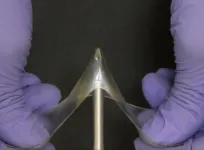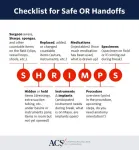(Press-News.org) A new study suggests that certain drugs commonly used to treat enlarged prostate may also decrease the risk for dementia with Lewy bodies (DLB). This observational finding may seem surprising, but it mirrors previous work by the University of Iowa Health Care team that links the drugs to a protective effect in another neurodegenerative condition–Parkinson's disease.
The UI researchers think that a specific side effect of the drugs targets a biological flaw shared by DLB and Parkinson’s disease, as well as other neurodegenerative diseases, raising the possibility that they may have broad potential for treating a wide range of neurodegenerative conditions.
“Diseases like dementia with Lewy bodies, or Parkinson's disease, or Alzheimer's disease, are debilitating and we don't really have any good treatments that can modify the disease progression. We can treat symptoms, but we can't actually slow the disease,” explains lead study author Jacob Simmering, PhD, UI assistant professor of internal medicine. “One of the most exciting things about this study is that we find that same neuroprotective effect that we saw in Parkinson's disease. If there is a broadly protective mechanism, these medications could potentially be used to manage or prevent other neurodegenerative diseases.”
The new findings were published online on June 19, 2024, in Neurology®, the medical journal of the American Academy of Neurology.
DLB is a neurodegenerative disease that causes substantial and rapid cognitive decline and dementia. While less common than Parkinson’s disease, DLB affects about one in 1,000 people per year, and accounts for 3 to 7% of all dementia cases. Because aging is a key risk factor for DLB, it is likely to become more common as our population gets older.
For the new study, the UI researchers used a large database of patient information to identify more than 643,000 men with no history of DLB who were newly starting one of six drugs used to treat benign prostatic hyperplasia (enlarged prostate).
Three of the drugs, terazosin, doxazosin, and alfuzosin (Tz/Dz/Az), have an unexpected side effect; they can boost energy production in brain cells. Preclinical studies suggest that this ability may help slow or prevent neurodegenerative diseases like PD and DLB.
The other drugs, tamsulosin and two 5-alpha-reductase inhibitors (5ARIs) called finasteride and dutasteride, do not enhance energy production in the brain and therefore provide a good comparison to test the effect of the Tz/Dz/Az drugs.
The team then followed the data on these men from when they started taking the medication until they left the database or developed dementia with Lewy bodies, whichever happened first. On average, the men were followed for about three years.
Because all the participants were selected to start a drug that treats the same condition, the researchers reasoned that the men were likely similar to each other at the outset of the treatment. The researchers also matched the men using propensity scores for characteristics like age, the year they started the medication, and other illnesses they had before staring the treatment, to further reduce the differences between the groups.
“We found that men who took Tz/Az/Dz drugs were less likely to develop a diagnosis of dementia with Lewy bodies,” Simmering says. “Overall, men taking terazosin-type medications had about a 40% lower risk of developing a DLB diagnosis compared to men taking tamsulosin, and about a 37% reduction in risk compared to men taking five alpha reductase inhibitors.”
Meanwhile, there wasn't a statistically significant difference in risk between men taking tamsulosin and 5-alpha reductase inhibitors.
This was an observational study and therefore the results show only an association between taking the Tz/Dz/Az drugs and a reduced risk of developing DLB rather than a causal relationship. In addition, the study only included men because the drugs are prescribed for prostate problems, which means that the researchers don’t know if the findings would apply to women. However, Simmering and his colleagues are excited by the potential of these drugs, which are already FDA approved, inexpensive, and have been used safely for decades.
“If terazosin and these similar medications can help slow this progression—if not outright preventing the disease—this would be important to preserving cognitive function and quality of life in people with DLB,” Simmering says.
In addition to Simmering, the team included UI neuroscience researchers Nandakumar Narayanan, MD, PhD, Georgina Aldridge, MD, PhD, and Qiang Zhang, MD, and Alexander Hart, MD, who is now at University of Michigan.
END
Drugs for enlarged prostate may also protect against dementia with Lewy bodies
2024-06-19
ELSE PRESS RELEASES FROM THIS DATE:
Titan’s lakes may be shaped by waves
2024-06-19
Titan, Saturn’s largest moon, is the only other planetary body in the solar system that currently hosts active rivers, lakes, and seas. These otherworldly river systems are thought to be filled with liquid methane and ethane that flows into wide lakes and seas, some as large as the Great Lakes on Earth.
The existence of Titan’s large seas and smaller lakes was confirmed in 2007, with images taken by NASA’s Cassini spacecraft. Since then, scientists have pored over those and other images for clues to the moon’s mysterious ...
YALE EMBARGOED NEWS: Family psychiatric history: Effects on siblings of children with autism
2024-06-19
New Haven, Conn. — Children who have an older sibling with autism spectrum disorder (autism) are at greater risk of developmental vulnerabilities if they also have other relatives with neurodevelopmental or psychiatric conditions, according to a new study from the Yale Child Study Center.
Researchers found that the siblings of children with autism had an increase in the severity of social and communication difficulties — which are common in autism — if they had relatives with conditions such as schizophrenia or anxiety. Family histories of anxiety and intellectual disability were also associated ...
New technology provides electrifying insights into how catalysts work at the atomic level
2024-06-19
A team led by Lawrence Berkeley National Laboratory (Berkeley Lab) has invented a technique to study electrochemical processes at the atomic level with unprecedented resolution and used it to gain new insights into a popular catalyst material. Electrochemical reactions – chemical transformations that are caused by or accompanied by the flow of electric currents – are the basis of batteries, fuel cells, electrolysis, and solar-powered fuel generation, among other technologies. They also drive biological processes such as photosynthesis ...
Researchers create new class of materials called ‘glassy gels’
2024-06-19
Researchers have created a new class of materials called “glassy gels” that are very hard and difficult to break despite containing more than 50% liquid. Coupled with the fact that glassy gels are simple to produce, the material holds promise for a variety of applications.
Gels and glassy polymers are classes of materials that have historically been viewed as distinct from one another. Glassy polymers are hard, stiff and often brittle. They’re used to make things like water bottles or airplane windows. Gels – such as contact lenses – contain liquid and are soft and stretchy.
“We’ve created a class of materials ...
Tabulae Paralytica: Mapping the biology of spinal cord injury in unprecedented detail
2024-06-19
Scientists at EPFL have achieved a significant research milestone in the field of spinal cord injuries—mapping out the cellular and molecular dynamics of paralysis in unprecedented detail with their open-source project 'Tabulae Paralytica'. Grégoire Courtine and his team have integrated cutting-edge cell and molecular mapping technologies with artificial intelligence to chart the complex molecular processes that unfold in each cell after spinal cord injuries (SCI). Published in Nature, this seminal ...
When in drought: Researchers map which parts of the Amazon are most vulnerable to climate change
2024-06-19
In the late 2000s, Scott Saleska noticed something strange going on in the Amazon rainforest.
In 2005, a massive drought struck the region. Two years later, Saleska – a University of Arizona professor in the Department of Ecology and Evolutionary Biology – published surprising research that used satellite images to find that the drought resulted in more green growth in large swaths of the Amazon. On the other hand, field researchers saw plants brown and some die in response to the drought.
Research published today in the journal Nature reveals what caused the scientific mismatch. Shuli Chen, a doctoral degree candidate in ecology and evolutionary ...
Standardized OR handoffs significantly improve surgical communication and patient safety
2024-06-19
Key Takeaways
The introduction of a standardized handoff protocol substantially improved communication among OR staff, ensuring critical information was transferred consistently.
The enhanced communication reduced potential patient safety risks and highlighted the importance of standardized handoff tools in improving surgical outcomes.
CHICAGO (June 19, 2024) — A new study showcases a successful quality improvement program that significantly enhances surgical safety. By implementing a standardized handoff protocol, known as SHRIMPS, the study demonstrates how ...
Immune response study explains why some people don't get COVID-19
2024-06-19
Scientists have discovered novel immune responses that help explain how some individuals avoid getting COVID-19.
Using single-cell sequencing, researchers from the Wellcome Sanger Institute, University College London (UCL), Imperial College London, the Netherlands Cancer Institute and their collaborators, studied immune responses against SARS-CoV-2 infection in healthy adult volunteers, as part of the world's first COVID-19 human challenge study1. Not all exposed participants went on to develop a COVID-19 infection, ...
New research illuminates the ecological importance of gray wolves in the American West
2024-06-19
Corvallis, OR — A study published today in the journal BioScience sheds light on the importance of gray wolves in western United States. Led by William Ripple, a scientist at Oregon State University and the Conservation Biology Institute, the research delves into the implications of large predator absence on plant and animal communities, and ecosystem functions. It calls attention to “shifting baselines” wherein increasingly degraded conditions are viewed as reflecting the historical state of a system.
"By the 1930s, wolves were largely absent from the American West, including its national parks. Most published ecological ...
Forgotten predators: Ecological understanding is often marred by the exclusion of extirpated species
2024-06-19
New research published in the journal BioScience describes how the removal large predators is often unrecognized in ecological scholarship, creating an issue of "shifting baselines," with profound implications for restoration efforts.
A team led by researchers from Oregon State University, including co-lead authors William J. Ripple and Christopher Wolf, reviewed 96 published studies from 1955 to 2021 that were conducted in 11 national parks where gray wolves had been extirpated. Their analysis found that ...







